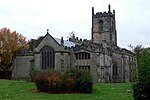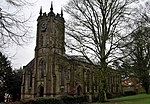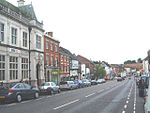Ashby de la Zouch Castle

Ashby de la Zouch Castle is a ruined fortification in the town of Ashby-de-la-Zouch, Leicestershire, England. The castle was built by William, Lord Hastings, a favourite of Edward IV, after 1473, accompanied by the creation of a 3,000-acre (1,200 ha) park. Constructed on the site of an older manor house, two large towers and various smaller buildings had been constructed by 1483, when Hastings was executed by Richard, Duke of Gloucester. The Hastings family used the castle as their seat for several generations, improving the gardens and hosting royal visitors. During the English Civil War of the 1640s, Henry, a younger son in the Hastings family, became a Royalist commander in the Midlands. He based himself at the castle until he was forced to surrender it after a long siege. A fresh rebellion occurred in 1648, leading Parliament to slight the castle in order to prevent it being used militarily: the two towers were badly damaged with gunpowder and undermining. Parts of the remaining castle were turned into a new house and continued to be used by members of the Hastings family for many years, although they moved their main residence to Donington Hall. The castle became famous after it featured in Sir Walter Scott's novel Ivanhoe in 1819, and its owner, Francis Rawdon, opened the ruins to visitors. Restoration work was carried out over the course of the next century, but by 1932 the Rawdon family could no longer afford to maintain the castle. It passed into the guardianship of the Ministry of Works, who carried out extensive repairs and opened the castle gardens. In the 21st century, the castle is managed by English Heritage as a tourist attraction, receiving 15,164 visitors in 2015. The historian John Goodall considers the site to be an "outstanding example of a late medieval castle", with its grounds forming "one of the best-preserved and most important" examples of an early Tudor garden.
Excerpt from the Wikipedia article Ashby de la Zouch Castle (License: CC BY-SA 3.0, Authors, Images).Ashby de la Zouch Castle
South Street, North West Leicestershire
Geographical coordinates (GPS) Address Website External links Nearby Places Show on map
Geographical coordinates (GPS)
| Latitude | Longitude |
|---|---|
| N 52.746132 ° | E -1.4664382 ° |
Address
Ashby de la Zouch Castle (Ashby Castle)
South Street
LE65 1BR North West Leicestershire
England, United Kingdom
Open on Google Maps








